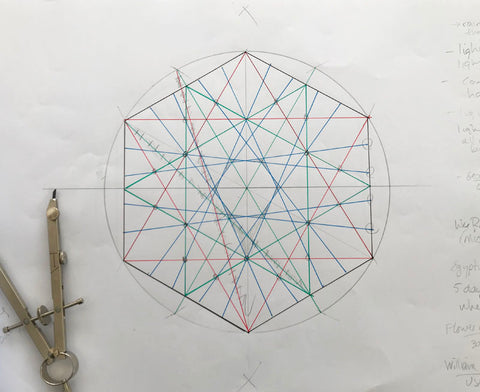The Geometry of Snowflakes, A winter exploration ❄❄❄

I recently attended another fantastic online workshop with Adam Tetlow (See also The Starcut Diagram) who took us on a seasonable deep dive into the geometry of snowflakes, explaining some of the physical, almost mystical, properties these miniscule natural sculptures share. He then broke down how to produce images of a selected few he had analyzed and divided into their harmonic parts. The discussions around both how snowflakes take shape and the process of producing them were so fascinating, I could understand why their mysteries have delighted the curious for centuries!

In 1611, the German astronomer and polymath Johannes Kepler was so enamored by the question of a snowflake's form and creation, he examined it as a gift to a fellow academic. In the essay he wonders...
"There must be a cause why snow has the shape of a six-cornered starlet. It cannot be chance. Why always six? The cause is not to be looked for in the material, for vapour is formless and flows, but in an agent.
What is that agent? An immanent form, or an efficient cause acting from outside? Did it stamp the shape on the stuff as the stuff demanded, or out of its own nature as expressing either the beauty of the hexagon or the purpose it subserves?" ~ J.Kepler, The Six-Cornered Snowflake (from synopsis)


"Why do snowflakes when they are falling and before they become entangled and form larger snowflakes, have six corners and are clustered like feathers.” Johannes Kepler, The Six-Cornered Snowflake
Below is the process I attempted during Adam's workshop to produce one of the more intricate snowflakes. He led us through the step-by-step method for creating several foundational layouts which would then all be used for one final drawing. Each layout had a break-down of a particular ratio- thirds, quarters, fifths, etc... All contained in the one snowflake. The idea would be to ultimately create a type of "master grid", with each proportion divided within the background drawing- so a final layout could be used to re-create a multitude of snowflake designs. A noble and all- encompassing task!








"The essence of the beautiful is unity in variety.”― W. Somerset Maugham

Thank you for your interest! If you enjoy my work, feel free to follow me at @tamaraclark_art on Twitter and Instagram or sign up for my Newsletter.